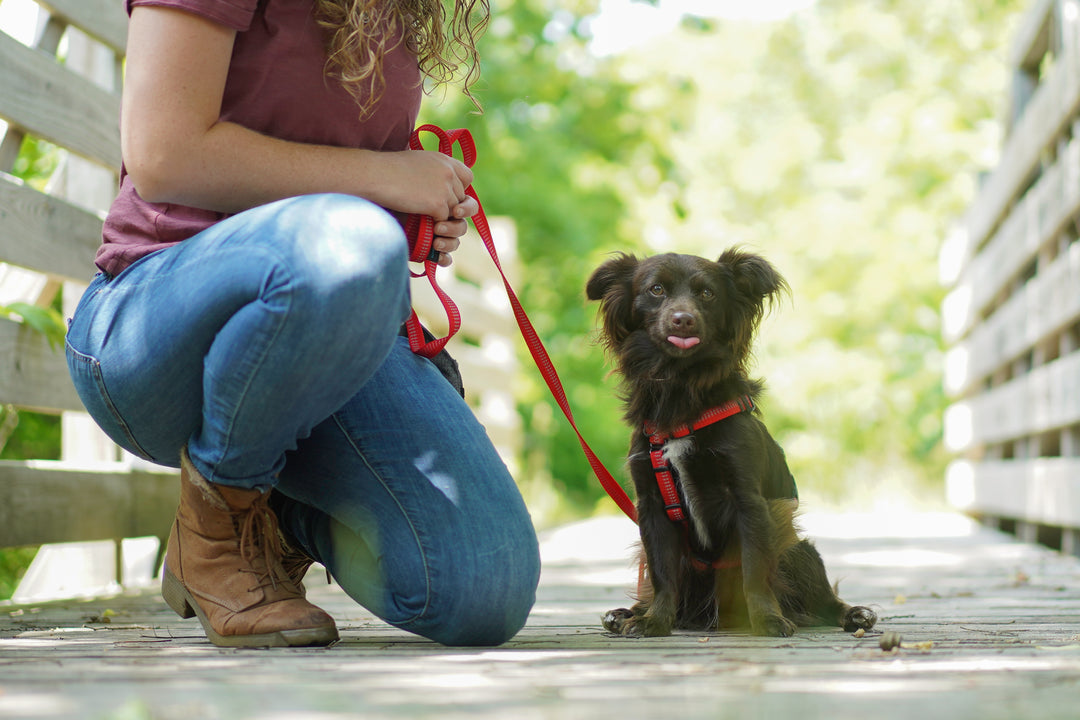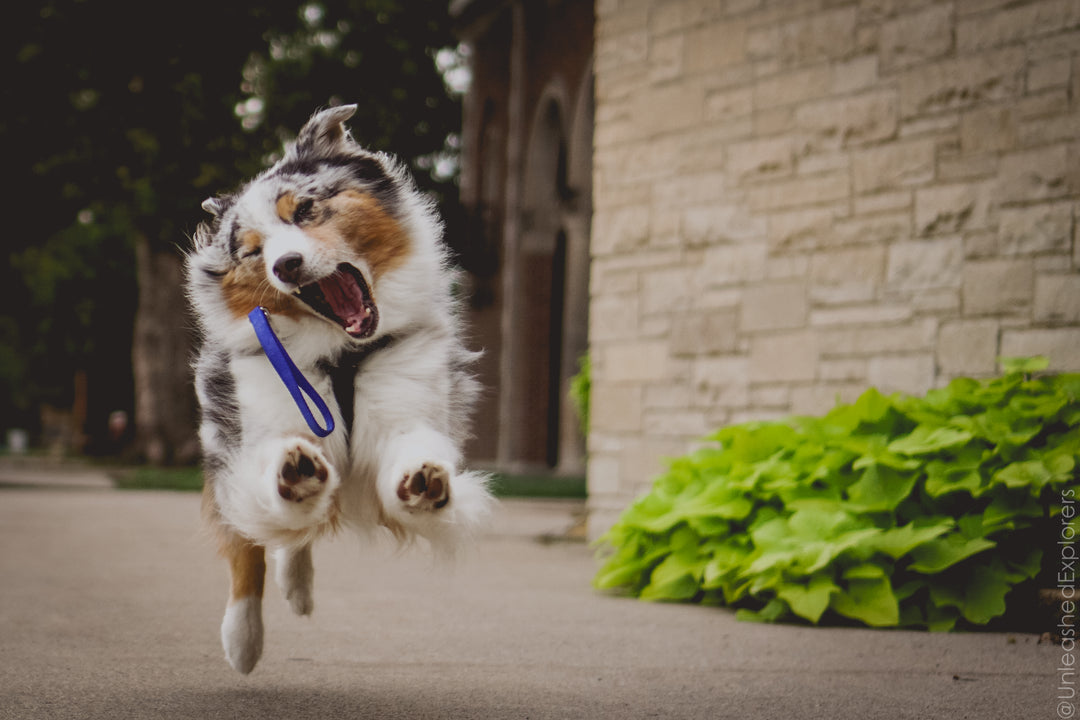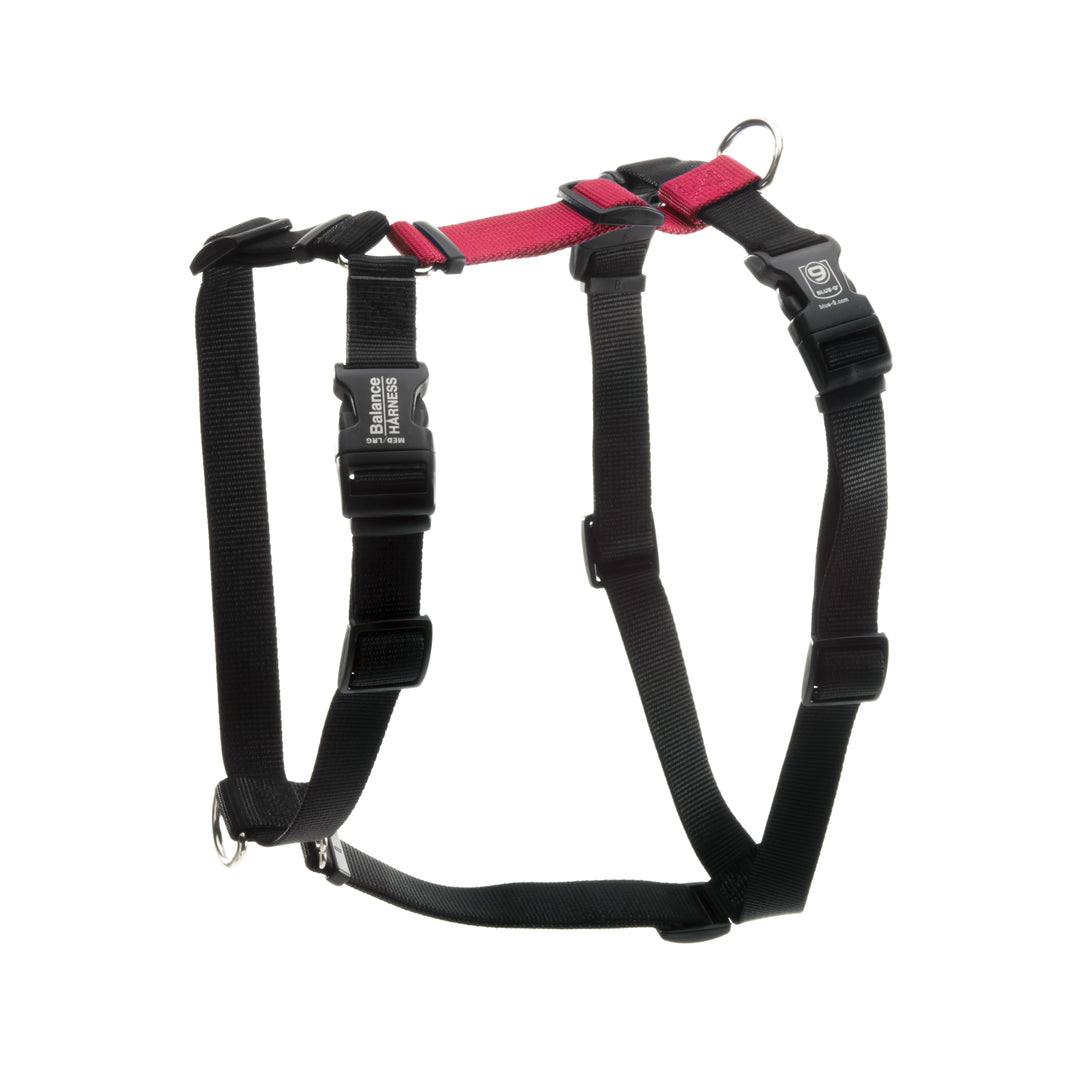Introducing Your Dog To The Klimb®
A STEP-BY-STEP GUIDE TO TRAINING YOUR DOG WITH A PLATFORM
The first step to training your dog with the KLIMB is to get him to jump up onto it. There are many methods to doing this. If your dog is fearful of the KLIMB, start your training without installing the legs. Note: If you are using the KLIMB without legs attached, be sure to use cap-plugs to prevent injuries. You can order cap-plugs at www.blue-9.com. If you happen to have a dog that offers the behavior of jumping onto the KLMB with minimal or no prompting, mark and reward. Repeat the steps below, but without a treat in your hand. Instead of using a lure, use a simple hand gesture.
If your dog doesn’t offer jumping onto the KLIMB, use a lure.
- With a treat in your hand, place it at the dog’s nose and slowly lure him up onto the KLIMB. Mark and reward.
- If your dog chooses to stay on the KLIMB continue to mark and reward.
- Allow your dog to jump off after a few repetitions.
- Repeat the luring process until your dog is very comfortable jumping onto the KLIMB.
- Once comfortable, try gesturing towards the KLIMB without food in your hand. Your dog should jump onto the KLIMB. Mark and reward.
ADDING DISTANCE
We want to be able to move freely around our dogs while they are on their KLIMB. We may want them to rest on their KLIMB 10 feet away from us while we cook dinner, or watch television. To be able to do this, we need to be able to move away from our dog.
- Cue your dog to jump onto the KLIMB. Mark and reward.
- Take one step away from the KLIMB. Mark and return to your dog to reward.
- After a few successful repetitions, take two steps away from the KLIMB. Mark and return to your dog to reward.
- Add distance one step at a time by building it in slowly. Be sure to release and reset your dog occasionally.
- If at any point your dog makes a mistake, decrease your criteria. Remember the Move-Stick-Drop rule.
ADDING A SIT
When we ask our dogs to get on the KLIMB, we will want them to perform a stationary behavior while they are on the KLIMB. You can choose to have your dog sit or down.
- Cue your dog to jump onto the KLIMB.
- Cue your dog to sit. Mark and reward.
- Gesture for your dog to get off the KLIMB.
ADDING THE “KLIMB” CUE
When your dog is comfortable jumping on and off the KLIMB, and you are able to get him to jump onto the KLIMB with a simple gesture instead of a lure, you are ready to add a cue.
- Say your new cue, “KLIMB,” followed by your old cue, gesturing toward the KLIMB. When your dog performs the behavior, mark and reward.
- Repeat the process, saying the new cue followed by the old cue. Continue to mark and reward.
- With repetition, your dog will learn to follow the verbal cue and you will not have to use the hand gesture.
ADDING A RELEASE CUE
Eventually, we will want our dog to stay on the KLIMB until we give him permission to get off. To do this, we will add a release cue. Some examples of a release cue are “Release,” “Break,” “Free,” or “All done.”
- Cue your dog to jump on the KLIMB. Mark and reward.
- Say your release cue, and then gesture for your dog to get off the KLIMB. You may have to toss a treat/reward on the ground for your dog the first couple of times.
- With practice, your dog will learn that when he hears the release cue, he has permission to jump off. Once your dog understands this new skill, do not reward your dog after the release cue. We want almost all of our rewards to happen on the KLIMB.
- At this time, we have not built in any duration for staying on the KLIMB. If your dog makes a mistake and jumps off the KLIMB before you have given your release cue, simply gesture for your dog to get back on the KLIMB, pause brie y, and then give your release cue. With the next repetition, you can reward your dog for jumping onto the KLIMB.
ADDING THE THREE DS
We want our dogs to be able to stay on the KLIMB for as long as we ask them to no matter how far away the handler walks, and no matter the number of distractions that appear. We will build up the following areas slowly over time: distance, duration, and distractions.
- Distance – How far the handler can be away from the dog.
- Duration – How long the dog will stay on the KLIMB.
- Distractions – How successful the dog is at remaining on the KLIMB in the presence of distractions.
MOVE-STICK-DROP RULE
As we increase our criteria for what our dogs have to do in order to earn a treat, we need to remember the Move-Stick-Drop rule. If our dog is successful in 8/10 trials, we can move up in our criteria. If our dog is successful in 5–7 out of 10 trials, we will stick to the same criteria. If our dog is successful in less than 5/10 trials we should drop our criteria down to a lower level.
ADDING DURATION
We want our dogs to maintain their position on the KLIMB for a duration of time. We may want them to rest on their KLIMB while we eat dinner, visit with friends, or train another dog. To be able to do this, we need to build the duration our dogs will stay on their KLIMB.
- Cue your dog to jump onto the KLIMB. Pause briefly, then mark and reward.
- Add duration in short increments.
- After a few successful repetitions, mark and reward your dog for staying on the KLIMB for 3 seconds.
- After a few successful repetitions, mark and reward your dog for staying on the KLIMB for 5 Seconds.
- Build duration slowly. Be sure to release and reset your dog occasionally. Take a short play break after approximately 10 repetitions.
- If at any point your dog makes a mistake, decrease your criteria. Remember the Move-Stick-Drop rule.
ADDING DISTRACTIONS
Eventually, we want our dogs to be able to maintain their position on the KLIMB no matter what the distraction may be. It is important that the distractions are easy to manage and control in order to “proof” the behavior. Start with simple distractions, and then build up to higher-level distractions. Remember to increase your criteria slowly over time. We will discuss an example using a toy.
- Cue your dog to jump onto the KLIMB. Mark and reward.
- Show your dog the toy. Mark and reward if your dog stays on the KLIMB.
- After a few successful repetitions, slowly wiggle the toy around. Mark and reward if your dog stays on the KLIMB.
- After a few successful repetitions, squeak the toy. Mark and reward.
- After a few successful repetitions, gently toss the toy up in the air. Mark and reward.
- After a few successful repetitions, drop the toy on the ground. Mark and reward.
- Be sure to release and reset your dog occasionally.
- Use more distracting toys.
- Practice with food.
- Use other distractions available in your environment.
- If at any point your dog makes a mistake, decrease your criteria. Remember the Move-Stick-Drop rule.
FINAL REMINDERS
Remember that consistency is key with dog training. If you are not training or maintaining a behavior, you will lose it. Keep your training sessions short and fun! Our dogs are our partners, it is our job to make performing acceptable behaviors reinforcing.
For more training tips and videos check out the "Learn" section at www.blue-9.com.
NEED MORE TRAINING INFORMATION?
Check out our KLIMB Training DVD. Follow along with Jamie with our step by step training DVD.




